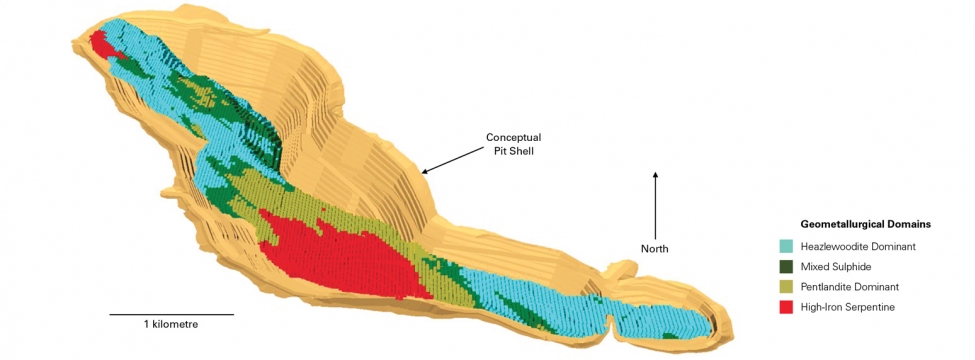To serve you better, our new website displays information specific to your location.
Please visit the site and bookmark it for future use.
You are here
SRK Kazakhstan ›Estimating metallurgical variability: a case study
After discovering a mineral deposit, delineating the drilling, and developing a geological framework, the next step is usually estimating metal content by quantifying the grade and tonnage of the mineral occurrence. To support mine design and the economic analysis of the project, a geometallurgical model can also be generated by bridging the gap between the geostatistics and the metallurgy. SRK generated such a geometallurgical model for Royal Nickel Corporation’s (RNC) Dumont nickel deposit, located in the established Abitibi mining camp, 25km northwest of Amos, Québec, Canada.
In 2013, RNC commissioned SRK to produce a mineral resource model to support a feasibility study. The model estimated 9.7 billion pounds of nickel resources in the Measured and Indicated category and 2.9 billion pounds of nickel the Inferred resource category. The feasibility study concluded that the Proven and Probable reserve categories contain approximately 6.9 billion pounds of nickel. Once in operation, the mine is expected to rank as the fifth-largest nickel sulphide mine in the world by annual production, and to last more than 30 years.
The deposit comprises pervasively serpentinised olivine + sulphide cumulates which make up differentiated layers of the Dumont sill, a komatiitic intrusion contained within the Archean Abitibi Greenstone Belt.
Nickel mineralisation within the deposit is characterised by disseminated blebs of pentlandite ((Ni,Fe)9S8), heazlewoodite (Ni3S2), and the ferronickel alloy awaruite (Ni2.5Fe) occurring in various proportions throughout the sill. These minerals can occur together as coarse agglomerates, or as individual disseminated grains. Nickel can also occur in the crystal structure of several silicate minerals including relict olivine and serpentine. This mineralogical variability must be accurately modelled in order to calculate recovery for the feasibility study.
To investigate the correlation between mineralogy and metallurgical recoveries, RNC completed a detailed Quantitative Evaluation of Minerals by Scanning Electron Microscopy (QEMSCAN) study. They analysed 1,420 samples to provide detailed mineralogical information on mineral assemblages, nickel deportment, liberation, alteration and the variability of these factors. Mineralogical samples were also taken to characterise the metallurgical domain composites and for mineralogical mapping.
The results were used to construct estimation models of mineral abundances. SRK modelled the abundance distribution of awaruite, brucite, coalingite, heazlewoodite, serpentine, low-iron serpentine, iron-rich serpentine, magnetite, olivine, and pentlandite.
In conjunction with defining the nickel grade, the models were used by RNC to establish four distinct metallurgical domains: heazlewoodite dominant, mixed sulphide, pentlandite dominant, and high-iron serpentine. A separate regression recovery equation was determined by RNC for each domain, and was applied to the resource on a block-by-block basis to calculate a net smelter return per tonne, which was subsequently used to support a feasibility study.
Sébastien B. Bernier: sbernier@srk.com
|
You can download a PDF of the entire |
PDF
A4 |
PDF
Letter |
|
|
|
Our newsletters focus on specific areas of interest to earth resource professionals and clients. Each is available as an Adobe Acrobat PDF file. If you don't already have Adobe's PDF reader, you can download it free.


